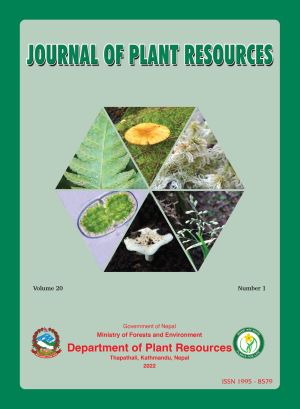Community Structure, Regeneration Status and Tree Biomass of Shorea robusta Gaertn. in Charpala Community Forest, Rupandehi District, Central Nepal
DOI:
https://doi.org/10.3126/bdpr.v20i01.56589Keywords:
Biomass, Carbon stock, Population structure, Regeneration, SalAbstract
Sal is a multipurpose tropical tree that grows as the dominant plant species in Nepal’s lowlands. A comparative study of the Sal population structure was carried out in two blocks of Charpala Community Forest, Rupandehi. A total of 161 species of vascular plants, belonging to 135 genera and 69 families, were recorded, where Fabaceae (26 species) was the dominant family. Densities of Sal trees, saplings, and seedlings per hectare were 4000, 1945, and 742 respectively. A reverse J-shaped curve in the population structure of Block 1 indicated active natural regeneration. However, in Block 2, the lower densities of seedlings and saplings, and the higher densities of intermediate diameter classes indicated insufficient spontaneous regeneration. Average tree biomass and carbon stocks were 522.49 Mg/ha-1 and 245.57 Mg/ha-1, respectively. While Block 2 outperformed Block 1 in terms of tree density, carbon stock, and biomass, Block 1 had the higher density of seedlings and saplings, which improved the regeneration status of that site. Increased demand for lumber for construction has put existing Sal strands in Nepal under pressure. Therefore, a detailed study of its population makeup and natural renewal is crucial.




